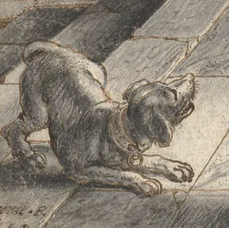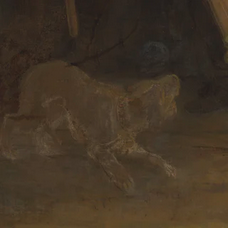Original Drawing of the Dog in Rembrandt's Night Watch discovered

Rembrandt based the barking dog in The Night Watch on an early 17th-century drawing by Adriaen van de Venne (1590–1662), as revealed by art historical research carried out as part of Operation Night Watch, the largest and most comprehensive study ever undertaken of Rembrandt’s most famous painting.
The remarkable resemblance between Rembrandt’s dog and the dog on the drawing, that has been in the Rijksmuseum collection for over a hundred years, was recently discovered.
Taco Dibbits, General Director Rijksmuseum: "It is remarkable that new discoveries are still being made about one of the most studied paintings in the world, almost 400 years after it was made. This finding gives us yet more insight into Rembrandt’s thought processes when creating this work."

Detail of the dog, Adriaen Pietersz van de Venne, Frontispiece Design for Jacob Cats, Self-Strijt, 1619
The most striking similarity is the identical rotation of each dog’s head, with both looking upward in the same direction, their mouths slightly open. Another matching feature is the dark line indicating the position of the right eye. In addition, the skullcap of both animals is divided into two sections, and their collars closely correspond. There are small differences, however: the nose of the dog in The Night Watch is slightly flatter, for example, and its ears hang further down. Rembrandt also made his dog’s mouth slightly more open, and added a tongue.
The pose of the two dogs is similar, too. As in Rembrandt’s painting, Van de Venne’s drawing depicts the dog positioned diagonally within the picture plane, with its upper body close to the ground. The biggest difference is that the dog in The Night Watch stands on all four legs, whereas Van de Venne’s lies on its front legs, with its chest against the ground. Unlike in the drawing, the tail and the hind legs are visible in The Night Watch.
In the recently discovered underpainted sketch which was made visible using MA-XRF (macro X-ray fluorescence) analysis, it can be seen that the dog in The Night Watch was initially depicted with its right front leg more bent, and the chest closer to the ground. In this first rendering, the dog’s pose in The Night Watch was even more similar to Van de Venne’s drawing.

Detail of the dog, Adriaen Pietersz van de Venne, Frontispiece Design for Jacob Cats, Self-Strijt, 1619
The drawing was made in 1619 by artist, poet and publisher Adriaen van de Venne (1590–1662), and depicts the biblical story of Joseph being tempted by Potiphar’s wife. It is a design for the title page of Self-stryt, dat is, Krachtighe beweginghe van Vlees ende Gheest (Self-Conflict, or, The Powerful Motions Between the Flesh & Spirit) a popular book by Jacob Cats that was first published in 1620.
Besides the similarities between the dogs, there are other indications that Rembrandt must have been familiar with Van de Venne’s drawing. Rembrandt explored the same theme in his 1655 painting Joseph Accused by Potiphar’s Wife, in which Joseph’s hand gesture and upward gaze strongly recall the pose of the central figure of Joseph in the drawing. An etching by Rembrandt titled Joseph and Potiphar’s Wife (1634) also bears similarities with the bed scene in the background of the drawing. Rembrandt owned a very large collection of prints and drawings by other artists, but whether it included Van de Venne’s drawing is not known. He made use of a variety of existing prints, drawings and other sources for the poses of several militiamen portrayed in The Night Watch.
Main Image: Comparison of the dogs by Rembrandt and Van de Venne
